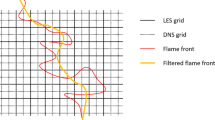Abstract
Direct numerical simulation is a very powerful tool to evaluate the validity of new models and theories for turbulent combustion. In this paper, direct numerical simulations of spherically expanding premixed turbulent flames in the thin reaction zone regime and in the broken reaction zone regime are performed. The flamelet-generated manifold method is used in order to deal with detailed reaction kinetics. The computational results are analyzed by using an extended flame stretch theory. It is investigated whether this theory is able to describe the influence of flame stretch and curvature on the local burning velocity of the flame. It is found that if the full profiles of flame stretch and curvature through the flame front are included in the theory, the local mass burning rate is well predicted. The influence of several approximations, which are used in other existing theories, is studied. When flame stretch is assumed constant through the flame front or when curvature of the flame front is neglected, the theory fails to predict the local mass burning rate. The influence of using a reduced chemistry model is investigated by comparing flamelet simulations with reduced and detailed chemistry.
Similar content being viewed by others
References
Peters, N., Turbulent Combustion. Cambridge University Press, Cambridge (2000).
Damköhler, G., Der Einfluß der Turbulenz auf die Flammen-geschwindigkeit in Gasgemischen. Z. Elektrochem. 46 (1940) 601–652.
Spalding, D.B., Mixing and chemical reaction in steady confined turbulent flames. Proc. Combust. Inst. 13 (1971) 649–657.
Bray, K.N.C. and Moss, J.B., A unified statistical model of the premixed turbulent flame. Acta Astronautica 4 (1977) 291–319.
Duclos, J.M., Veynante, D. and Poinsot, T.J., A comparison of flamelet models for premixed turbulent combustion. Combust. Flame 95 (1993) 101–117.
Marble, F.E. and Broadwell, J.E., The Coherent Flame Model for Turbulent Chemical Reactions. Technical Report TRW-9-PU, Project Squid (1977).
de Goey, L.P.H. and ten Thije Boonkkamp, J.H.M., A flamelet description of premixed laminar flames and the relation with flame stretch. Combust. Flame 119 (1999) 253–271.
van Oijen, J.A. and de Goey, L.P.H., A flamelet analysis of the burning velocity of premixed turbulent expanding flames. Proc. Combust. Inst. 30 (2004).
Baritaud, T., Poinsot, T.J. and Baum, M. Direct Numerical Simulation for Turbulent Reacting Flow. Editions Technip, Paris (1996).
Gashi, S., Hult, J., Jenkins, K.W., Chakraborty, N., Cant, R.S. and Kaminski, C.F., Curvature and wrinkling of premixed flame kernels – comparisons of OH PLIF and DNS data. Proc. Combust. Inst. 30 (2004).
Hawkes, E.R. and Chen, J.H., Direct numerical simulation of hydrogen-enriched lean premixed methane-air flames. Combust. Flame 138 (2004) 242–258.
Thévenin, D., Three-dimensional direct simulation and structure of expanding turbulent methane flames. Proc. Combust. Inst. 30 (2004).
Echekki, T. and Chen, J.H., Unsteady strain rate and curvature effects in turbulent premixed methane–air flames. Combust. Flame 106 (1996) 184–202.
van Oijen, J.A. and de Goey, L.P.H., Modelling of premixed laminar flames using flamelet-generated manifolds. Combust. Sci. Technol. 161 (2000) 113–138.
Lipatnikov, A.N. and Chomiak, J., Molecular transport effects on turbulent flame propagation and structure. Prog. Energy Combust. Sci. 31 (2005) 1–73.
Williams, F.A., Combustion Theory. Addison-Wesley, Redwood city, CA (1985).
Chung, S.H. and Law, C.K., An integral analysis of the structure and propagation of stretched premixed flames. Combust. Flame 72 (1988) 325–336.
Groot, G.R.A., van Oijen, J.A., de Goey, L.P.H., Seshadri, K. and Peters, N., The effects of strain and curvature on the mass burning rate of premixed laminar flames. Combust. Theory Model. 6 (2002) 675–695.
van Oijen, J.A. and de Goey, L.P.H., Modelling of premixed counterflow flames using the flamelet-generated manifold method. Combust. Theory Model. 6 (2002) 463–478.
Clavin, P. and Williams, F.A., Effects of molecular diffusion and of thermal expansion on the structure and dynamics of premixed flames in turbulent flows of large scale and low intensity. J. Fluid Mech. 116 (1982) 251–282.
Groot, G.R.A. and de Goey, L.P.H., A computational study on propagating spherical and cylindrical premixed flames. Proc. Combust. Inst. 29 (2002) 1445–1451.
Matalon, M., On flame stretch. Combust. Sci. Technol. 31 (1983) 169–181.
Groot, G.R.A., Modelling of propagating spherical and cylindrical premixed flames. PhD Thesis, Technische Universiteit Eindhoven (2003).
Lele, S.K., Compact finite difference schemes with spectral-like resolution. J. Comput. Phys. 103 (1992) 16–42.
Wray, A.A., Minimal Storage Time-advancement Schemes for Spectral Methods. Technical Report, NASA Ames Research Center (1990).
Poinsot, T.J. and Lele, S.K., Boundary conditions for direct simulations of compressible viscous flows. J. Comput. Phys. 101 (1992) 104–129.
Schlichting, H., Boundary Layer Theory, McGraw-Hill Series in Mechanical Engineering. McGraw-Hill Book Company, New York (1960).
Smooke, M.D. and Giovangigli, V., Formulation of the premixed and nonpremixed test problems. In: Lecture Notes in Physics, Vol. 384 (1991) pp. 1–28.
Maas, U. and Pope, S.B., Simplifying chemical kinetics: Intrinsic low-dimensional manifolds in composition space. Combust. Flame 88 (1992) 239–264.
Gicquel, O., Darabiha, N. and Thévenin, D., Laminar premixed hydrogen/air counterflow flame simulations using flame propagation of ILDM with preferential diffusion. Proc. Combust. Inst. 28 (2000) 1901–1908.
Smith, G.P., Golden, D.M., Frenklach, M., Moriarty, N.W., Eiteneer, B., Goldenberg, M., Bowman, C.T., Hanson, R.K., Song, S., Gardiner, W.C., Jr., Lissianski, V.V. and Qin, Z., GRI-Mech 3.0 Website, http://www.me.berkeley.edu/gri_mech 1999.
Bastiaans, R.J.M., Groot, G.R.A., van Oijen, J.A. and de Goey, L.P.H., Application of FGM to DNS of premixed turbulent spherical flames. In: Chauveau, C. and Vovelle, C. (eds.), Proceedings of the European Combustion Meeting (2003).
CHEM1D, A one-dimensional laminar flame code. Eindhoven University of Technology.
Author information
Authors and Affiliations
Corresponding author
Rights and permissions
About this article
Cite this article
Van Oijen, J.A., Bastiaans, R.J.M., Groot, G.R.A. et al. Direct Numerical Simulations of Premixed Turbulent Flames with Reduced Chemistry: Validation and Flamelet Analysis. Flow Turbulence Combust 75, 67–84 (2005). https://doi.org/10.1007/s10494-005-8592-3
Received:
Accepted:
Issue Date:
DOI: https://doi.org/10.1007/s10494-005-8592-3




